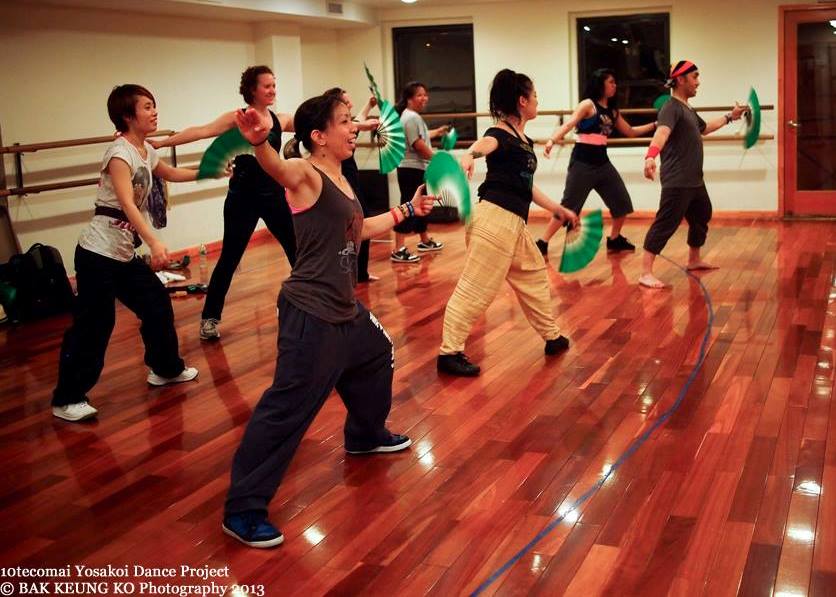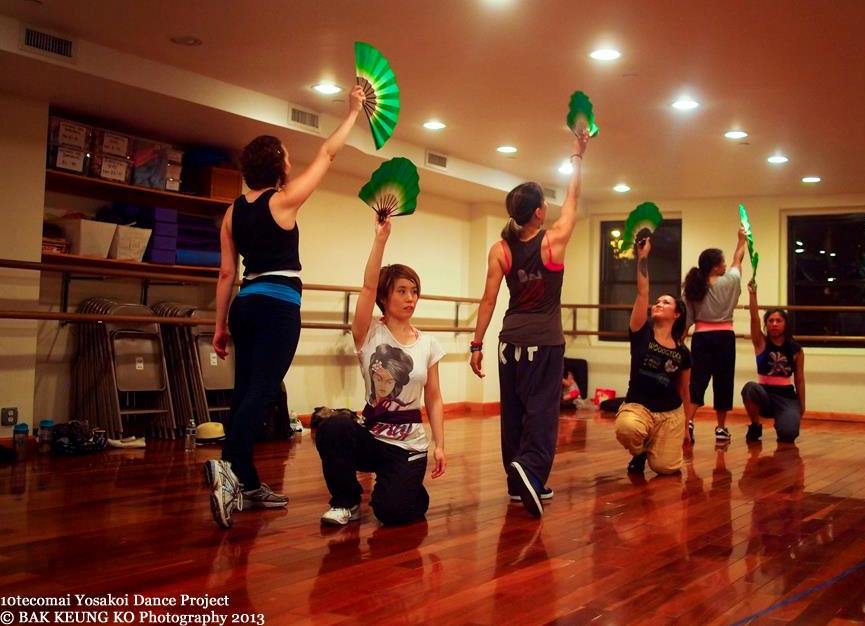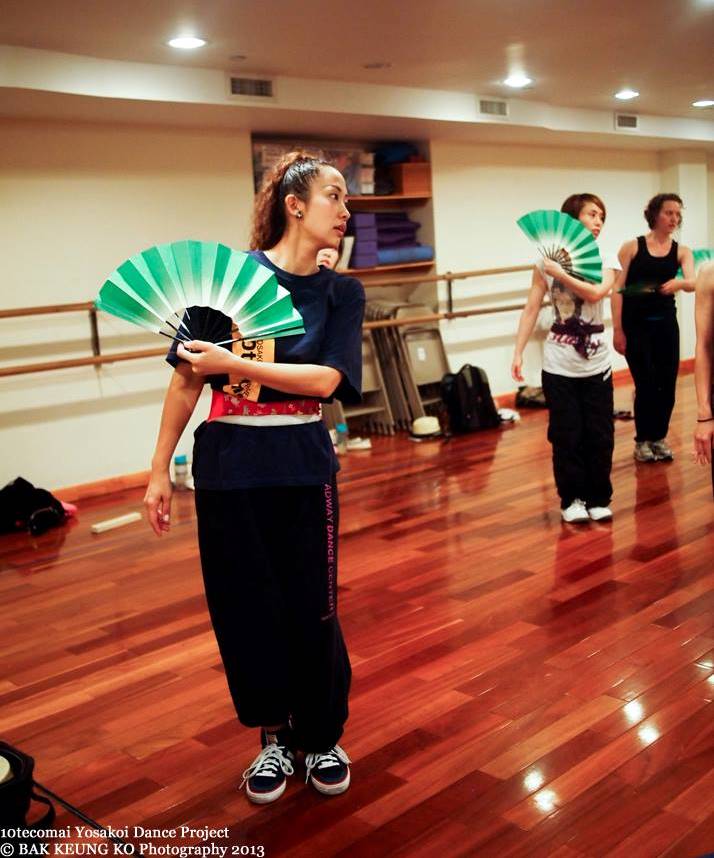By Bak Keung Ko
AsianInNY got to sit down with New York’s very own yosakoi dance group, 10tecomai Yosakoi Dance Project, for an exclusive interview! While entering the studio, I was able to watch them rehearse and it was such an amazing experience. They were so energetic and upbeat that it became contagious and got me hyped for my interview with Tomas Trinidad, 10tecomai’s current dance director.
Can you tell us, what is 10tecomai?
T: 10tecomai is a performance group and our style of performance is yosakoi. Yosakoi is a style of dance which originated from the Kochi region of Japan a little over 60 years ago. It is a fusion of traditional Japanese movement with contemporary styles of music and dance. It is always evolving and always changing. There are two main aspects to it, incorporating traditional Japanese movement and being positive and uplifting. It’s a very energetic style of dance and usually performed at matsuris. Matsuri in Japanese means celebration, hence why yosakoi is festive itself, to spread positivity and energy to their audience. We are currently the only team in the U.S. that does yosakoi style.
Are you one of the founders?
T: No, I actually joined in a year after it was founded. The original founder entrusted the team to me after he moved back to Japan. I’m currently the second oldest member in the team.
So who is the first?
T: My wife, she joined the company before me and introduced me to it. I just joined shortly after and I fell in love with the dance.
Are the members all friends and family?
T: No, we were strangers when we first met, but we’re all friends now. The only family is my wife. Everyone else started as onlookers who saw our performances, took an interest to learn. We speak in Japanese during our rehearsals and also use Japanese manners and customs. Many joined because they took an interest in that sort of performance style. They just came to us. We hold auditions, but for the most part, many people ask us if they could be a part of the group.
Are all of your members Japanese?
T: It’s about half and half actually. It’s good that we have a lot of diversity who want to learn because each specific person adds their own dimension to it and just helps the idea of yosakoi to be better. It’s a fusion style, so just having more than a Japanese personality heightens the style of dance and performance in general.
Is 10tecomai a special name? I know yosakoi is a specific type of dance.
T: The word itself has many meanings, depending on how it’s written. The kanji has different sorts of meanings to it. In some ways, 10tecomai means to be very, very busy. Originally it was written with the concept of “dance from the heavens”. The idea was inspirations come from a higher power, which give us the energy and in turn we give that energy out to the audience.
So this originated in New York?
T: Yes, we’re in our 9th anniversary. Next year will be our 10th year.
Do you do tours?
T: As of right now, no. But, during the cherry blossom season, our busiest times of the season, we do a lot of traveling. We go travel to the south and sometimes to the west side. It really depends on who is interested in our group. I mean, we’ve gotten as far as Indiana, DC, and we’re just looking to basically broaden our audience’s culture with yosakoi. As the knowledge of it grows in America, more people get interested and words spreads.
So I noticed you guys also make your own music. Where does that originate from?
T: Well, currently, we don’t have our own musicians for the setting. A lot of the music is from, pieces we’ve listened to that inspires us to create choreography out of that. A couple of our pieces are cover songs by other groups. That particular piece (current practice session) is from an anime called “A Ghost In A Shell”. We do have a couple of original pieces, but the idea really comes from the piece within. I couldn’t necessarily tell you where it comes from. It’s a spiritual sense that just comes from a higher power. Each one of our pieces has a different theme and message and it just comes when it comes. Do you know what I mean? It’s like we’re inspired by what we hear and what we see. If a particular song on the radio or a particular Japanese song hits us in a certain way that produces some kind of thought in our head. From the then, we try to make that thought a movement in our piece. We’re actually in the process of making two pieces now. All it takes is someone to say “you know I’d like to try a few songs and try to work it”— and it’s at work. We’ve done a lot of collaborative efforts with musical groups in NY, for example, Taiko Masala who we’re good friends with. We do collaborative efforts on occasion and in those instances, we just dance with feeling. They play and we dance, we move. At that point, it’s like freestyle, letting the music control your body.
So how does a normal 10tecomai practice session work? How long to practice one performance, etc.?
T: Usually we have a warm-up, which takes from thirty to forty-five minutes because it’s a very physical style of dance. It does require a lot of energy; we do a lot of training. There are a lot of different dance backgrounds here and it takes time to learn and adjust to a different motion and style. After the warm-up, we either prepare for a show with a two hours rehearsal or learn a new piece, which requires two hours learn. So generally, you’ll see our rehearsals run about two to three hours each for one rehearsal and come performance season, we’ll usually rehearse two to three times a week, just to prepare for the show and up our physical training. It’s always a workout (Doing this interview is actually a break so it’s good for me.)
Outside of practice, what do the members do?
T: Half of them are actually just like myself, have a steady occupation. Several of them dance. They come here to broaden their knowledge of dance. For the most part, a lot of the members here are New Yorkers, therefore we have different jobs and different lives. But the fact that we love this style of dance, we come together to learn. In Japan, yosakoi is done by all ages. You have teams comprised of grandparents; you have teams comprised of very small kids, there is no age limit when doing this style of dance. They come to have fun, to learn this style of dance, and that is the most important part. It really brings people together.
I see. Every time you have a performance, you guys seem to accumulate a lot of fans. That energy that you got, you send to the audience, it’s so popular and so great. How does that really work? Where does all this energy come from? For example, you two performances for one day like when you performed at Times Square and Brooklyn Botanical Garden in the past. Don’t you get tired?
T: Of course, but our pieces are meant to energize the audience, as well as our physical training. The mentality of why we’re doing this dance style is a lot of what empowers us to do it. Every style is different, to be in a jazz group, to be in a ballet group, to be in a hip hop group, and all these styles of dance are great. But, we are one of the only groups in America that does this style of dance. What really drives us is having people understand this style of dance charging us 100% every single time we’re on stage because only through that can people really enjoy this aspect of Japanese culture. So no matter how tired we are, as long as we remember why we’re doing it, and we continue to encourage the audience to cheer and feel the energy along with us, we can do it as many times. We can see the look on their faces; we see the smiles and their joy. That is what moves us, and when we do that, we just don’t stop until of course, it’s over. After that, we’re exhausted. But in that moment, as long as we remember why we’re doing this, we see the smiles; it just empowers to keep going no matter what.
Has your group always been succeeding or were there ups and downs?
T: Oh, I think in every group, there are ups and downs. I don’t look at anything as a down for us. I look at everything as a learning experience. If there are any downs, I view them as constructive criticisms because again, the aspect of yosakoi is supposed to be about positive energy. I can’t let any challenges get us down. I have always looked at it as a challenge that we can all strive together. If anyone of our members is having a tough time, we come together as group to raise their spirits back up. So there really is not much negativity that is too much for us to handle. I’d like to think of everything as just – if anything, it’s all ups and learning experiences.
I noticed on the website that some people have left the group. How does that affect the group overall?
T: I mean that’s another thing. People have their own lives. Some of them returned to Japan for various reasons, visas or things like that. That doesn’t detract from the fact that they have learned yosakoi from us. Whatever people may do in the future, I’d like to believe that their experiences with us have affected them in a positive way. It does not matter where there are residing in this world, we will still be friends. It’s just for a lot of people, our performance and training schedule is very rigorous, and with these reasons, some people have to leave, and I understand that. But you know, then again for every one or two people who leave, there are still one or two people who still want to learn. It’s a rotation, because there’s always people who want to watch and want to be a part, they want to learn about us. As long as people are interested and have the desire for it, we’ll always have individuals who will be able to take part as a 10tecomai member. To that effect, as long as people believe in us, we’ll still be here.
For all your fans out there, if they’re striving to be like you or be as accomplished, do you have anything you want to tell them?
T: I mean, it’s whatever everyone says and I can’t stress it enough that if you have a dream and am willing and determined, you have to go for it. Seek help from those in the know, they can assist you and help you throughout your journey. I, myself didn’t have that many people helping me when I was taking over 10tecomai and teaching this style of dance. After all, we are the only group in almost all of America doing this, but luckily with the help of teammates, with the help of Japanese culture fans, we managed to keep going for this long. The same advice holds true for anyone who wants to start their own yosakoi team, you just have to go for it and seek help wherever you can find it. Yosaki is about teamwork and it’s okay to ask for help. Hopefully there will be more yosaki teams in the near future. I’m looking forward to your performances.
Last question. Do you have any upcoming events?
T: We’re going to be doing a workshop at a karate dojo at the Upper West Side this month and currently we’re working with the Japanese supermarket Mitsuwa in NJ. We’re working on performing at their annual Summer Matsuri event in mid-August. We’re just working on that and whatever else comes along in the fall. You can always check us out on Facebook and also www.10tecomai.com.
For more information about 10tecomai Yosakoi Dance Project, visit www.10tecomai.com.






Leave a Reply